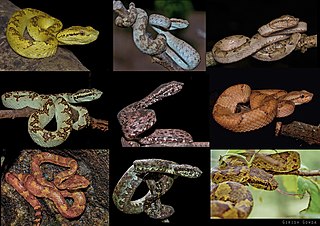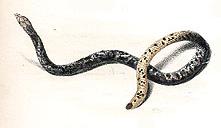The Uropeltidae, also commonly known as shield tail snakes, shield-tailed snakes or earth snakes, are a family of primitive, nonvenomous, burrowing snakes native to Peninsular India and Sri Lanka. The name is derived from the Greek words ura ('tail') and pelte ('shield'), indicating the presence of the large keratinous shield at the tip of the tail. Seven or eight genera are recognized, depending on whether Teretrurus rhodogaster is treated in its own genus or as part of Brachyophidium. The family comprises over 50 species. These snakes are not well known in terms of their diversity, biology, and natural history.

Craspedocephalus strigatus, commonly known as the horseshoe pit viper, is a venomous pitviper endemic to the Western Ghats of India. No subspecies are currently recognized.
Beddome's worm snake is a species of harmless blind snake in the family Gerrhopilidae. The species is native to southern India. No subspecies are currently recognized.
Gerrhopilus thurstoni, or Thurston's worm snake, is a species of harmless blind snake in the family Gerrhopilidae. The species is native to western India. No recognized subspecies exist.

Craspedocephalus macrolepis, commonly known as the large-scaled pit viper, is a venomous pitviper species endemic to the Southern Western Ghats of South India. No subspecies are currently recognized.

Craspedocephalusmalabaricus, commonly known as Malabar pit viper, Malabar rock pit viper, or rock viper, is a venomous pit viper species endemic to the High-moderate elevations of western ghats of southwestern India.Recently this species complex was splited to three different species, Craspedocephalus malabaricus, Craspedocephalus travancoricus(South of shengottai gap), Craspedocephalus anamallensis(south of palghat gap upto North of shengottai gap).
Platyplectrurus trilineatus, commonly known as the Tri-striped shieldtail snake or the lined thorntail snake, is a species of uropeltid snake endemic to the Western Ghats of Southern India. Like most other shieldtail snakes, it is presumed to be a nocturnal, fossorial snake inhabiting evergreen forests. A very rare snake, about which nothing is known in terms of live colouration and natural history.
The purple-red earth snake is a species of nonvenomous shield tail snake, endemic to southern India. No subspecies are currently recognized.
Uropeltis ceylanica is a species of nonvenomous shieldtail snake in the family Uropeltidae. The species is endemic to the Western Ghats of South India. No subspecies are currently recognized as being valid, but the presence of several synonyms, many recently resurrected, calls for further taxonomic studies of this species complex. It is a burrowing snake with a pointy head equipped to penetrate the soil. It has a thick tail which looks as if it has been cut at an angle. In Kerala it's called iru thala moori, which means two headed organism, as the tail end looks like another head. It primarily eats earth worms.
Uropeltis dindigalensis, commonly known as the Dindigul uropeltis and the Sirumalai Hills earth snake, is a species of snake in the family Uropeltidae. The species is endemic to Sirumalai and surrounding hill ranges of the southern Eastern Ghats, in Dindigul district of Tamil Nadu state in South India.
Uropeltis macrorhyncha is a species of nonvenomous snake in the family Uropeltidae. The species is endemic to India. There are no subspecies that are recognized as being valid.

Uropeltis maculata, also known commonly as the spotted earth snake and the spotted shieldtail, is a species of nonvenomous snake in the family Uropeltidae. The species is endemic to southern India. There are no subspecies that are recognized as being valid.
Uropeltis nitida is a species of nonvenomous shieldtail snake. The species is endemic to southern India. There are no subspecies that are recognized as being valid.

Uropeltis rubromaculata is a species of nonvenomous shieldtail snake in the family Uropeltidae. The species is endemic to southern India. There are no subspecies that are recognized as being valid.
Uropeltis is a genus of nonvenomous shield tail snakes endemic to Peninsular India. As of 2022, 26 species are recognized as being valid.

Plectrurus is a genus of nonvenomous shield tail snakes endemic to the Western Ghats of South India. Currently, four species are recognized. They inhabit high elevation montane Shola forests and are usually found under fallen logs and rocks. Some species are rare while some are quite common in their range.

Rhinophis is a genus of nonvenomous shield tail snakes found in Sri Lanka and South India. Currently, 24 species are recognized in this genus. Of the 24 species, 18 are endemic to Sri Lanka, while six are endemic to South India.

Melanophidium is a genus of nonvenomous shield tail snakes endemic to the Western Ghats of India. These species are identifiable by having a mental groove in their chin shields. Currently, four species are recognized, including one newly described species.

Crotalus stejnegeri, commonly known as the Sinaloan long-tailed rattlesnake or just long-tailed rattlesnake, is a venomous pit viper species in the family Viperidae. The species is native to western Mexico. There are no recognized subspecies.
Teretrurus rhodogaster is a species of nonvenomous shield tail snake, endemic to the Western Ghats of India. It is known as Wall's shield tail snake, Palni Mountain burrowing snake, or red-bellied shieldtail.









